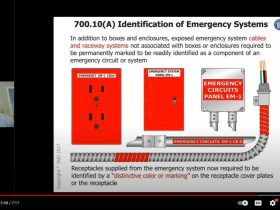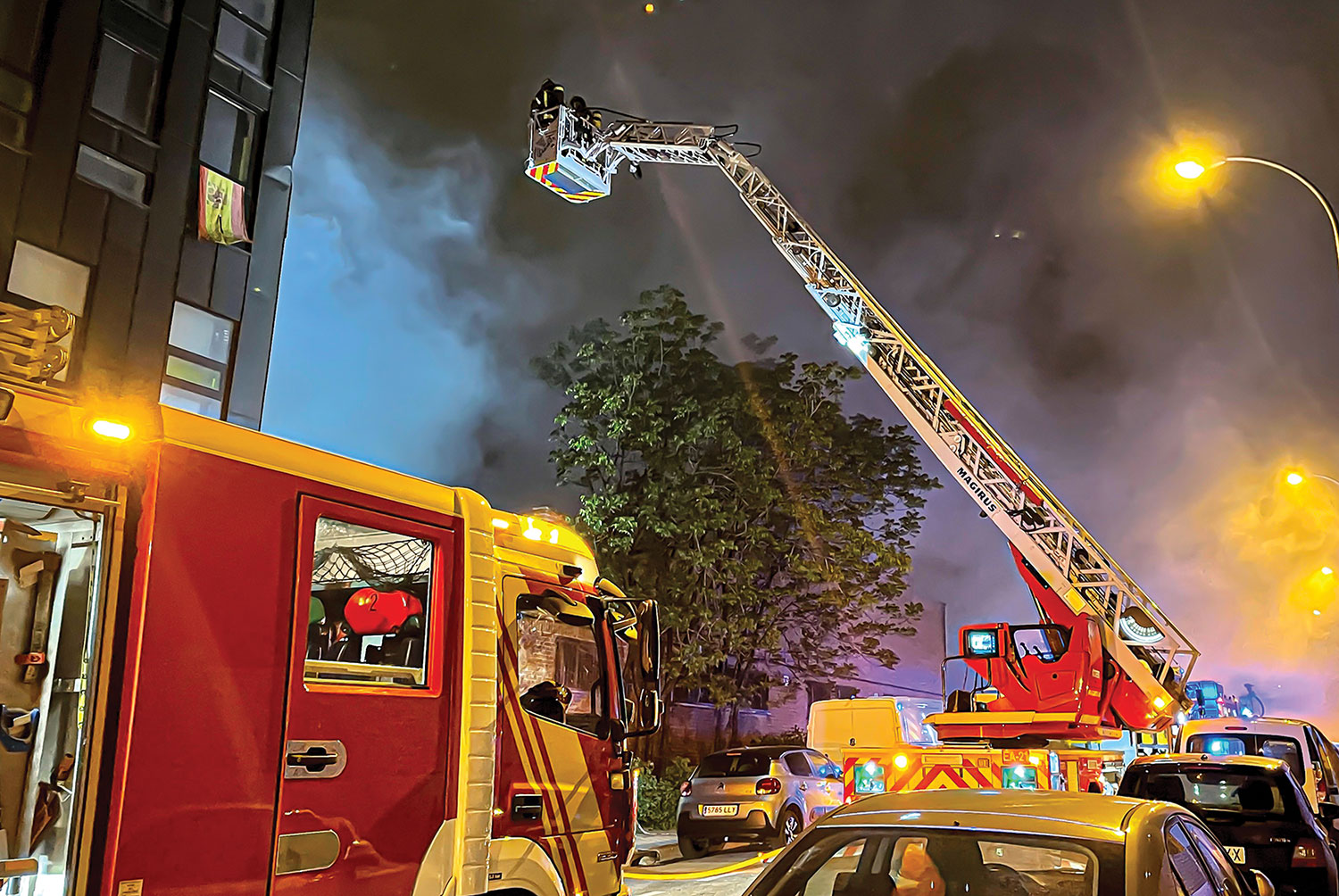Emergency systems in buildings or structures can vary in size and complexity. Some basic emergency systems provide illumination of the egress paths through unit equipment connected to local area lighting circuits. Other more complex and multiple function emergency systems provide power not only for lighting for the egress path but for many other essential functions, such as smoke control systems, life support systems, fire pumps, life support systems and equipment, etc.
This article focuses on several essential elements of inspecting all emergency systems, starting with the electrical system plan review and not ending until the satisfactory completion of the witness test.

Photo 1. Unit equipment shown with two luminaires heads mounted on the equipment
Electrical System Plan Review
If there is an engineered set of plans for the project, the engineer’s design should be followed. When the building inspection department includes a plan review process as part of its construction permit and conformance assessment process, the plan review of the project is generally the first part of a complete code-enforcement program.
Plan reviewers verify the emergency source to be used, the distribution system, and the lighting provided in the egress paths and at exits. On more complex systems, other loads should also be verified. It should be noted that, generally, only emergency loads are permitted to be connected to the emergency system, and these could include more than just lighting loads in some cases [see FPN No. 3 to 700.1]. The type and location of the emergency system source as well as transfer equipment must be checked. The load on an emergency system should also be verified to determine adequate capacity of the system in accordance with 700.5. This requirement assures enough system capacity to power all emergency loads at the same time, which becomes even more critical if there are high capacity emergency loads, such as fire pumps, connected to the emergency system. Although any misjudgment in calculating the system capacity will become apparent during the system witness test or load-bank testing, problems can be more easily addressed at this early stage.
There are other important elements of the emergency system design that should be checked in the plan review process. When the emergency system consists only of unit equipment (battery back-up) illumination for the egress paths and exits, then verification of the circuits to which that equipment is connected should be verified.
The plan review team must work cooperatively with the electrical field inspection staff. This is the most thorough and effective method of attaining code-compliance. When there is no electrical plan review, whether it is a small alteration or a larger and more complex project, the job of the electrical inspector in the field is much more difficult. It is the field inspector who provides the final and time-consuming verification that electrical installations and systems meet the minimum requirements of the applicable codes and standards. The importance of electrical plan review to the code-conformance assessment process cannot be understated. It is essential.
Capacity of the Emergency System Source
Arguably the most important characteristic of the emergency system is that it has adequate capacity for the intended load. There are a few key inspection issues that relate directly to the capacity of an emergency system, and which differ based on the type of system or source used.
When inspecting a battery-powered system, verify that the charging and storage capacity of the batteries meet the time durations and other specific requirements contained in 700.12(A). Battery powered systems must operate under emergency conditions for a minimum of 1½ hours and the voltage applied to the load must not fall below 87½ percent of the normal battery voltage.
If unit equipment (battery back-up units) is provided as the emergency system, the equipment must consist of the following components in accordance with 700.12(F):
1. A rechargeable battery
2. A battery charging means
3. Provisions for one or more lamps mounted on the equipment, or shall be permitted to have terminals for remote lamps, or both
4. A relaying device arranged to energize the lamps automatically upon failure of the supply to the unit equipment (see photo 1).
Or the unit equipment shall supply and maintain not less than 60 percent of the initial emergency illumination for a period of at least 1½ hours. Unit equipment, generally, is required to be connected to the normal lighting branch circuit serving the area and is required to be connected to the branch circuit ahead of any local switches to maintain continuous power to each unit. An exception to 700.12(F), for separate and uninterrupted areas served by at least three branch circuits, allows a separate branch circuit to supply the unit equipment for the area as long as the separate circuit originates from the same panelboard as the other lighting circuits and the branch circuit is provided with a lock-on feature.
An important and often overlooked requirement for unit equipment is the wiring method allowed for the dc circuits supplying remote luminaires that obtain emergency (battery) power from unit equipment but are not part of the unit equipment. The dc circuits run to remote luminaries supplied by the unit equipment must be installed in a wiring method specified in Chapter 3. Flexible cord-and-plug connections are permitted for the supply wiring for unit equipment provided the cord length does not exceed 3 feet.
Calculating the correct capacity for generator-type emergency systems involves verification of the connected load and comparing it to the capacity of the generator. (Remember to include all emergency loads, including the fire pump load if one is provided). Section 700.5(B) has additional information about the allowances for load shedding and peak load shaving process.
When an emergency system has a generator with a combustion engine as the prime mover, the capacity of the fuel system is an important factor. Where internal combustion engines are used as the prime mover, an on-site fuel supply shall be provided with an on-premise fuel supply sufficient for not less than 2 hours’ full-demand operation of the system. Where the generator prime mover is fueled by a public utility gas system it must not depend on that one fuel supply alone. Where two fuel supplies are used, they must be arranged for automatic transferring from one supply to the other in the event of failure in one of the supply systems. The primary focus is redundancy of the fuel supply to assure reliability of the emergency system.
Rough-in Wiring Inspection
Once the project is underway, inspections of the field-installed electrical wiring and equipment are performed at various stages of construction to verify compliance with the code. There are a few key points for inspecting an emergency system during the rough-in stages of a construction project.

Figure 1. Location of the emergency system source is an important design consideration
Before stepping onto the site, the inspector must understand the single-line diagram and be able to identify essential components of the emergency system and the emergency distribution system. During an initial visit to the jobsite, the field inspector has an obligation to verify that the planned location of the emergency system source will not be subject to adverse conditions such as flooding, icing or fire. This important design consideration is required by 700.9(C). Note: During the plan review process there is limited ability to verify the suitability of the source location and/or the proper use of equipment. Although these are considerations for the engineer or design professionals, the field inspector always has the right to examine their decision and to question prior approvals. Any questioning usually is done in the plan review stages of a project. This is just another of many good reasons for having electrical plan review as part of any inspection team (see figure 1).

Figure 2. Locations where emergency circuits and normal circuits are permitted within the same enclosure
The rough inspection of any construction project that has an emergency system should include the awareness that emergency system conductors, generally, are not permitted to be installed in the same raceways or enclosures with the normal circuit conductors. There are four conditions where emergency system wiring and normal wiring are permitted to occupy the same enclosures, such as transfer equipment, exit or emergency luminaries, etc., as indicated in 700.9(B)(1) through (4) [see figure 2]. This requirement is to minimize the possibility of failures in the normal system circuits causing damage to the emergency system circuits. It should be understood that emergency systems are required to operate in the event of a premise crisis situation, which often includes the loss of normal power. Failure of the emergency system during these conditions is a safety issue and can be avoided by compliance with the Code. Good emergency system designs strive for redundancy on many levels, often exceeding the minimum requirements of the applicable codes and standards.
Emergency System Equipment Approvals
Product listing is the basis for the final installation approval. Sometimes the Code specifically requires certain types of equipment to be listed, but in the case of equipment used in constructing an emergency system, approval is required. The general requirement in Section 700.3 is that all equipment used in an emergency system be approved; and approved is defined in the NEC as “acceptable to the authority having jurisdiction.” This is a valuable and effective tool for the inspectors who are charged with the task of approving electrical installations and systems. While electrical equipment may be manufactured to product safety standards and be listed, this section mandates the inspection and approval of the entire emergency system. Listed equipment has been evaluated for electrical safety and is identified for a specific use, so the inspector must verify that the equipment is installed and used in accordance with those installation instructions.

Figure 3. Transfer equipment is required to be identified for use on emergency systems
Inspectors should verify that transfer equipment is of the automatic type and is identified for use on emergency systems in accordance with 700.6. Identified is defined in the Code as “recognizable as suitable for the specific purpose, function, use, environment, application, and so forth, where described in a particular Code requirement” (see figure 3). Generally, the means of determining suitability of equipment for specific purposes, environments, uses or other applications includes product evaluation by a qualified testing laboratory (listing and labeling), an inspection agency, or other organizations concerned with product evaluations. Field evaluation services are also available to assist inspectors in the approval process.
Field Marking and Identification Requirements

Figure 4. Equipment and enclosures are required to be readily identifiable as a component of an emergency system
Equipment and enclosures used in emergency systems are required to be permanently marked so that they can be readily identified as components of the emergency system in accordance with 700.9(A) [see figures 4 and 5]. This verification often occurs as equipment and wiring are being installed during the early phases of a project, but much of the equipment marking is also verified during the final inspection process. One example of readily identifiable as a component of an emergency system is substantial labeling that states the word “emergency” in the text of the label such as “Emergency Transfer Switch.” Marking a junction box cover for an emergency system branch circuit with “E-1, 3, 5″ is an example of noncompliance with this requirement. This marking is not readily identifiable. The local authority having jurisdiction has the final word as to what is acceptable and meets the requirements of permanent and readily identifiable as used in that Code rule.

Figure 5. Equipment and enclosures are required to be readily identifiable as a component of an emergency system
Another field-marking requirement in 700.8(A) requires a sign to be placed at the service-entrance equipment that indicates the type and location of the on-site standby system source. Once again, the local authority having jurisdiction has the final word as to what is acceptable and meets the requirement (see photo 2).
Several additional rules in Article 700 pertain to emergency system installations; we have highlighted only a few of the key areas above. Now, let’s place some specific emphasis in an essential part of inspecting electrical emergency systems: the witness test. Section 700.4(A) requires the AHJ to conduct or witness a performance test of the emergency system operation. This involves simulation of normal power failure, usually by operating the service disconnect to the open or off position. Witness testing of unit equipment used for the emergency system should be done by de-energizing the local area lighting circuits. This ensures that the unit equipment is properly connected to the lighting circuit in the area as required by 700.12(F).
Emergency System Witness Testing

Photo 2. Sign installed at service disconnect in compliance with 700.8(A)
TheNational Electrical Codeprovides primarily prescriptive rules and little in the way of performance or systems tests; however, a few performance tests are required. Two that come to mind immediately are the performance testing requirements for ground-fault protection systems as specified in Sections 230.95(C) and 517.17(C) and (D). These required tests are essentially are for equipment only—to ensure that the equipment functions properly under ground-fault conditions. In health care facilities, the performance testing for GFP equipment required by 517.17(C) and (D) not only demonstrates successful operation but also selectivity between the service and feeder ground-fault protection equipment.
The Code is specific in 700.4(A) in requiring the AHJ to conduct or witness a test of the complete emergency system upon installation. This is an acceptance performance test of a complete system, not just the equipment, and must simulate power failure and verify that the systems function as designed.
The extent of the witness test inspection is related to the complexity of the particular emergency system. Where unit equipment is involved, the test can be accomplished by switching the circuits supplying each area and verifying operation of the unit equipment and the minimum number of foot candles at the floor in the egress paths and at exits.
During the scheduled outage of the witness test, Code enforcement officials from various disciplines—such as the fire department, building inspector and mechanical inspector—can verify functions such as fire dampers, smoke evacuation and other systems connected to the emergency source. If only one inspector is responsible for all of aspects of the system, the witness testing can take an extended period of time.
When more complex emergency systems are supplied by generators, the witness testing of the system becomes more extensive, and verification of the fuel source is required. First, the normal power source is removed to verify that the generator starts and the load is transferred to the generator. All of this must happen within ten seconds of the loss of the normal supply power system. The emergency power must be connected to the occupancy within ten seconds of a power loss as required by 700.12, and can only be verified during a true witness test.
I recently had a conversation with an electrical inspector that included a discussion about a fairly large medical center that was nearing completion and needed a certificate of occupancy (C of O) for the project. The emergency system failed the witness test when the prime mover refused to start and, obviously, failed to power any of the emergency loads within ten seconds, or even at all. The electrical inspector said, “I’m sure glad we require witness testing of the emergency systems, especially with all the liabilities connected with the responsibilities of Code enforcement officials.” This inspector did his job by requiring the witness test and all parties concerned were reminded of the importance of conducting an operation test on the emergency system.
Specifically witnessing the emergency systems operation is an essential element of the inspection process and definitely qualifies as an electrical inspection hot spot.
Summary
A thorough inspection of an emergency electrical system must include the rough wiring of the system at various stages of construction and a witness test of the system performing its intended function. Since considerable investment and time goes into designing and installing an adequate and reliable emergency standby power system, testing protects both the investment and the expected performance.
An essential element of the approval process involves performance testing the system under full load conditions. This test requires simulating a failure of the normal supply power system to the building or structure. It is not the responsibility of the AHJ to perform the test by actually operating the equipment; rather, this task falls under the scope of the installer or owner. The AHJ must witness the test and generally will document the results. Methods of documentation will vary from jurisdiction to jurisdiction.
Periodic testing of the system is also required in accordance with 700.4(B). Documented incidents have demonstrated that emergency systems that are not performance tested or not tested on a regular basis after the initial installation, often fail to operate when called upon. Many jurisdictions have various remedies and interesting solutions for meeting this Code rule.
Approval of the electrical emergency system includes conducting or witnessing the system function as intended, and is not an option; it is a Code requirement. As always, it is best to consult your local AHJ for any additional requirements regarding emergency system witness tests or the Code.










Find Us on Socials